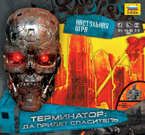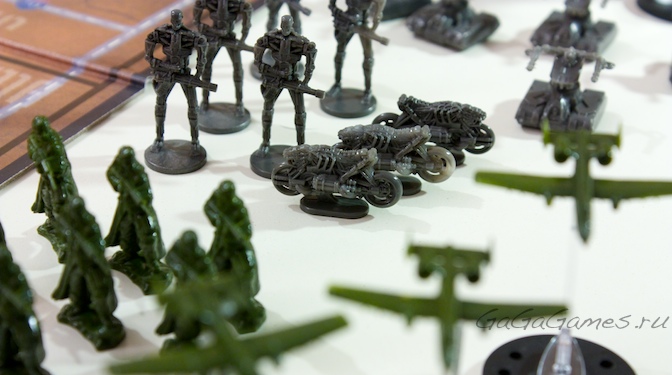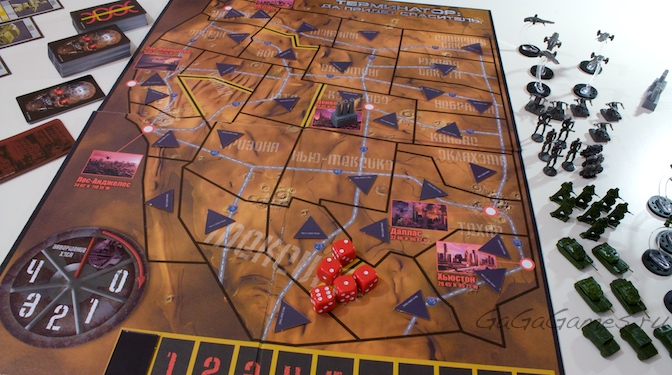Interview with the author of the board game “Terminator. May the Savior Come "by German Tikhomirov
 In 2009, the Russian company Zvezda released a board game licensed from the movie Terminator. May the savior come . ” In principle, the appearance of a board game under a well-known license is not big news - bookstores are inundated with crafts about Narnia, Winnie the Pooh, Barbie, Pirates of the Caribbean and their ilk not representing, by and large, no interest for a normal, mature, thinking person. In the case of the Terminator, however, an interesting thing came out - the game turned out to be of high-quality, interesting, with excellent miniatures and pleasant design.
In 2009, the Russian company Zvezda released a board game licensed from the movie Terminator. May the savior come . ” In principle, the appearance of a board game under a well-known license is not big news - bookstores are inundated with crafts about Narnia, Winnie the Pooh, Barbie, Pirates of the Caribbean and their ilk not representing, by and large, no interest for a normal, mature, thinking person. In the case of the Terminator, however, an interesting thing came out - the game turned out to be of high-quality, interesting, with excellent miniatures and pleasant design.We ( GaGaGames ) managed to talk with one of the authors of the board game Terminator. Let the savior come, ”the person in charge of game design (mechanics) of the game and the conversation went very interesting. We have always been interested in the backstage of creating games - how the game “comes up”, what comes before a
GaGaGames : Tell us in a few words about yourself. What do you do, how did fate bring you to board games, and how did you decide that your calling to create them?
Hermann : My name is Herman Tikhomirov. I am 33 years old. I live in
Of the hobbies that are not directly related to board games, one can name: history, military history, science fiction, role-playing games, historical reconstruction.
I play board games from early childhood. These were such simple walks as Baron Munchhausen, and a set of traditional board games “Our game store”. Pretty early on I also met such games as go, renju, and reversi. I played, of course, and chess. It is accurate to recall the moment when I decided to invent (or remake to my liking) a game myself, I guess I can’t. But there was one very bright episode.
In one of the popular children's magazines, they published The Game of the Ships (I think it was the Golitsin Pirates (1)). However, I only got the last number in my hands, where recommendations for making chips were made. From the text one could understand the general principles of the game, but only that. I wanted to play very much (I, in addition, shortly before that read “Odyssey of Captain Blood”)! Then I decided to correct the situation by inventing this game again. On sheets of thick paper, a field was drawn, chips were made of cardboard with silhouettes of ships. Were invented about
GaGaGames : How long have you been developing board games? How many are released? Which do you consider your most serious success and why?
Hermann : With the advent of the first board games for adults in our country, there was a desire to try our hand again. At first it was card collection games and processing of board games, which I did in my childhood. There was even an attempt to self-release the card collection game, but it failed.
')
For four years now I have been cooperating with the Zvezda company. In total, at the moment, about ten of my games have been released.
It’s too early to talk about success (If you don’t consider success in the fact that the game you came up with in the game), Terminator is the first game released that is meant for an adult player.

GaGaGames : Board game “Terminator. Yes, the Savior will come ”- one of the few Russian boards that has received a positive assessment of the gaming community. How long have you been working on it and what do you think is the most difficult thing when creating a game? Players would be interested to know how the game development takes place, how long the games are being tested, and so on.
Hermann : I worked on the Terminator for two months.
I cannot single
In general, the process of creating a game in my performance is approximately as follows:
- The birth of the idea of the game. Most often, there is initially a technical task, consisting of the theme of the game and the age of the intended players. This is probably the most creative stage. Most often, the formation of the primary concept of the game (the plot, the main mechanics used, the forms of realization) takes from 15 minutes to an hour. However, this is preceded by several days and sometimes weeks of free thinking on the subject of the game and the collection of information.
The complexity of this stage is self-evident. Additional problems arise with games based on films and cartoons, since the whole process of game development takes place before they are released to the screens. I have to think not only about the game itself, but also about how much it will correspond to the original work, most of the plot moves are not known to me. - Is it possible to play it in principle? After the primary concept was born, I (most often immediately) take an ordinary notebook in a cage and begin to write down what was born, make lists of elements / cards / characters / properties and the like, draw sketches of the field. Having created them some kind of game, I try to make several moves with myself. Often, many unrecorded moments are immediately found out. Very rarely after this concept has to be redone. Most often, after several fixes and additions, I get a sketch of the game with the basic elements of mechanics and design. All I get is shown to a few people. And if their opinion coincides with mine, then I proceed to the next stage.
Here difficulties arise if the primary concept was not very bright and complete. Usually, the clearer the image of the game is born, the simpler all its subsequent creation (at least, the smaller the number of rework). - What will it be? Next, I proceed to the manufacture of the layout of the game. Typically, a field is printed on the printer, cards, suitable chips, markers and other elements of which the game will be composed are selected.
Something is painted with pencils or felt-tip pens,something is cut out of thick cardboard. The preliminary version of the rules is written.
Here the complexity is purely mechanical, the more components in the game - the more time is required for their manufacture. Any player who uses card protectors will be able to imagine what it is like to stuffone and a half or two hundred cards into pockets, and you have to cut them out. Moreover, in the future, these cards can change, and the whole process will be repeated first at intervals oftwo or three test batches. - How to play it? Actually, then the first testing begins. Sometimes I am with myself, sometimes the first test games are played with other players. The rules, components and even the tasks of the game can change at this stage right during the game.
The difficulty here is the same as in the previous step. In addition, it takes a lot of attention, so playing, you need to think not only (and not so much) about victory, but also about the fact that the game requires changes, constantly rearranging under the new moments of the rules, thinking for several parties. - Is it worth playing this? After the game takes a
more or less complete form, its main testing begins. Familiar players are invited and already full games are played. At the same time, I try not to tell the rules myself, but to give them to the players to read, to check the correctness and completeness of their compilation.
The difficulty here is the need to spend a lot of time and attract a lot of different people. In addition, we regularly have to go back to the previous stages, figuring outthat something in the game requires rework.
By the time testing can be very different. This mainly depends on the complexity of the game and the number of improvements arising in the process. Most often for children's games I play from 10 to 20 games. Testing the Terminator took most of the time it was created.
Everything described above applies only to that part of the work on the game that I spend. Then begins a large and complex process of creating the design of the game, graphics, layout and so on, but those who are directly involved in this will tell better.

GaGaGames : Which board games do you prefer to play? Do you play your own development?
Hermann : I play a variety of games, but I prefer the strategy of "low" and "medium" gravity. Of the most beloved: Wings of War, Memories of the
And with your own games the situation is funny. As a matter of fact, you start to invent your games with the motivation to make the game you want to play yourself. At least I started from this. But it turned out that now it is work, and I do most of the games not to your taste, but to order. Naturally, I try not to do not interesting games, but most of them are focused on children, and on the subject and on the complexity of the rules.
There are several unreleased games that I sometimes play. But here the lack of a quality publication interferes, since the
In the Terminator, by the way, I play with pleasure.
GaGaGames : What do you think is the reason for the insufficient number of high-quality nastolok of Russian production and authorship? What do you think should be done to correct the situation?
Herman : In my opinion, this is due to the fact that it is easy to create a game, but the complexity of creating a really good game is very high.
Two more problems should be added to all the problems described above: so that the game would be good, not only would it just be played, and there would be no “holes” in the rules. It is necessary that in the game there was a certain trick, for which players will play this game, and not another one like it. At the same time, the author of the game is not able to appreciate it, if his close friends play his game with pleasure - this does not at all mean that people completely unfamiliar to the author will get the same pleasure from the game.
The second problem - do not give yourself a fake. Most of all this is manifested in the time spent on testing and reading the rules.
To all this it should be added that for a good game requires a good design, and high-quality edition.
Localization of the game requires only its translation (and often only the rule book and title booklet) and printing costs (which is not rarely done in the same printing houses as the original). At the same time, the quality of the game itself has already been tested by time.
It is no secret that, until very recently, board games (except chess and playing cards) in our country were considered entertainment exclusively for children. As a result, the creation of games was taken up by amateurs, people with desires, much more than skills. Of course, from nothing - it cannot turn out well right away, and the first domestic games were mostly failures. However, this is a necessary stage, without which the transition to the creation of good games is impossible.
I believe that the situation will inevitably change for the better.

GaGaGames : Your wishes to all players and people unfamiliar with the world of board games.
Hermann : I would like to wish those who play new interesting games, and those who do not yet have to discover the wonderful world of board games.
GaGaGames : A traditional question - are your creative plans for the future?
Herman : Plans are simple - make new games.
GaGaGames : Maybe
Herman : I would like to express my gratitude to all those people who, one way or another, contributed to my development as an author of games.
This is, first of all, my father and elder brother, thanks to whom I became interested in board games.
These are employees of the Zvezda company, thanks to which I was able to realize myself as an author.
And finally, these are all the people who surround me and who patiently play at what I invent.
GaGaGames : Herman, thank you very much for the interview and for the great game!
(1) - “Pirates” is a board game invented by Vladimir Mikhailovich Golitsyn in 1931. The history of the game can be found here.
Source: https://habr.com/ru/post/92199/
All Articles